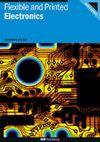Inkjet-Printed Transistors with Coffee Ring Aligned Carbon Nanotubes
IF 3.2
4区 工程技术
Q3 MATERIALS SCIENCE, MULTIDISCIPLINARY
引用次数: 0
Abstract
Low-concentration deposition techniques such as inkjet printing for forming carbon nanotube (CNT) transistor channels typically result in higher on-off current ratio, while lowering the field-effect mobility compared to traditional high-concentration techniques. In this paper, we show that inkjet-printed devices can have both high field-effect mobility and on-off current ratio by utilizing coffee ring induced thickness variation in the channel. The coffee ring effect occurs naturally in printed patterns with most solvents and substrates, and it pushes dissolved particles to the edges of printed features. Thickness variation and coffee ring effect are usually avoided in the channel of solution processed TFTs by implementing additional expensive steps in the fabrication process. Instead, here, we control these variations and utilize them to create inkjet-printed CNT channels with printing induced thickness variation that improves transistor properties. Printing properties such as printing speed, and number of layers are studied to manipulate capillary flow and form thicker line edges, which ultimately enhance current transport in the CNT network. A two-pass printing pattern with separate lines improves the field-effect mobility five times compared to a pattern with connected lines that has no defined edges. The field-effect mobility increases from 1.1 to 5.7 cm2/V.s at a drain voltage of -2 V.采用咖啡环排列碳纳米管的喷墨印刷晶体管
与传统的高浓度技术相比,用于形成碳纳米管(CNT)晶体管通道的喷墨打印等低浓度沉积技术通常会提高通断电流比,同时降低场效应迁移率。在本文中,我们展示了通过利用通道中咖啡环引起的厚度变化,喷墨打印器件可以同时具有较高的场效应迁移率和通断电流比。咖啡环效应在大多数溶剂和基底的印刷图案中自然产生,它将溶解的颗粒推向印刷特征的边缘。通常情况下,要避免溶液处理 TFT 沟道中的厚度变化和咖啡环效应,需要在制造过程中实施额外的昂贵步骤。而在这里,我们控制了这些变化,并利用它们创建了喷墨打印的 CNT 沟道,其打印诱导的厚度变化可改善晶体管特性。我们研究了打印速度和层数等打印特性,以控制毛细管流动并形成较厚的线边缘,最终增强 CNT 网络中的电流传输。与没有明确边缘的连线图案相比,具有独立线条的两道印刷图案可将场效应迁移率提高五倍。在漏极电压为 -2 V 时,场效应迁移率从 1.1 cm2/V.s 提高到 5.7 cm2/V.s。
本文章由计算机程序翻译,如有差异,请以英文原文为准。
求助全文
约1分钟内获得全文
求助全文
来源期刊

Flexible and Printed Electronics
MATERIALS SCIENCE, MULTIDISCIPLINARY-
CiteScore
4.80
自引率
9.70%
发文量
101
期刊介绍:
Flexible and Printed Electronics is a multidisciplinary journal publishing cutting edge research articles on electronics that can be either flexible, plastic, stretchable, conformable or printed. Research related to electronic materials, manufacturing techniques, components or systems which meets any one (or more) of the above criteria is suitable for publication in the journal. Subjects included in the journal range from flexible materials and printing techniques, design or modelling of electrical systems and components, advanced fabrication methods and bioelectronics, to the properties of devices and end user applications.
 求助内容:
求助内容: 应助结果提醒方式:
应助结果提醒方式:


